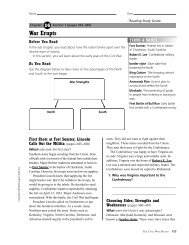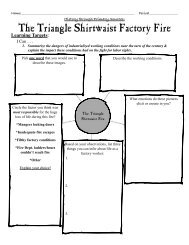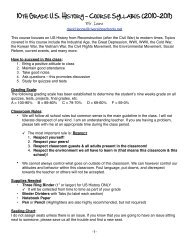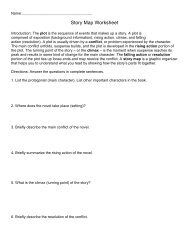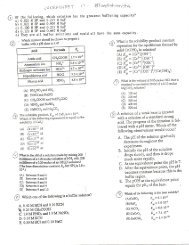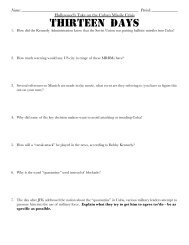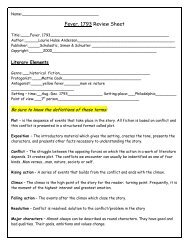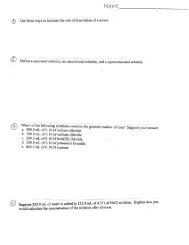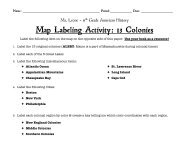Chapter 16 Text
Chapter 16 Text
Chapter 16 Text
You also want an ePaper? Increase the reach of your titles
YUMPU automatically turns print PDFs into web optimized ePapers that Google loves.
eMedia Exercises 659<br />
neuiolunach<br />
-inds<br />
^e or<br />
eine,<br />
tine,<br />
.io-5<br />
• paritr<br />
ilibriferto<br />
:isthe<br />
What<br />
lution<br />
el6.2.<br />
dorine<br />
ussion,<br />
In many reactions the addition of A1C13 produces the<br />
same effect as the addition of H+. (a) Draw a Lewis structure<br />
for A1C13 in which no atoms carry formal charges,<br />
and determine its structure using the VSEPR method.<br />
(b) What characteristic is notable about the structure in<br />
part (a) that helps us understand the acidic character of<br />
AlCls ? (c) Predict the result of the reaction between AIC13<br />
and NH3 in a solvent that does not participate as a reactant.<br />
(d) Which acid-base theory is most suitable for discussing<br />
the similarities between A1C13 and H+?<br />
[<strong>16</strong> llll What is the boiling point of a 0.10 M solution of NaHSO4<br />
if the solution has a density of 1.002 g/mL?<br />
(<strong>16</strong>.1121 Cocaine is a weak organic base whose molecular formula<br />
is CJ7H21NO4- An aqueous solution of cocaine was<br />
found to have a pH of 8.53 and an osmotic pressure of<br />
52.7 torr at 15QC. Calculate Kb for cocaine.<br />
[<strong>16</strong>.1131 The iodate ion is reduced by sulfite according to the following<br />
reaction:<br />
lO5~(acj) + 3SO32~(aq)^r(ac]) + 3SO42~(fli7)<br />
The rate of this reaction is found to be first order in IO3",<br />
first order in SO32~, and first order in H+. (a) Write the<br />
rate law for the reaction, (b) By what factor will the rate<br />
of the reaction change if the pH is lowered from 5.00 to<br />
3.50? Does the reaction proceed faster or slower at the<br />
lower pH? (c) By using the concepts discussed in Section<br />
14.6, explain how the reaction can be pH-dependent even<br />
though H+ does not appear in the overall reaction.<br />
[<strong>16</strong>.114] (a) Using dissociation constants from Appendix D, determine<br />
the value for the equilibrium constant for each of<br />
the following reactions. (Remember that when reactions<br />
eMedia Exercises<br />
^ <strong>16</strong>.1<strong>16</strong> You can measure the pH in the Acids and Bases simulation<br />
(e<strong>Chapter</strong> <strong>16</strong>.4) for aqueous solutions of 13 different<br />
compounds, (a) List the compounds available in the simulation,<br />
and identify each as a strong acid, a weak acid,<br />
a strong base, or a weak base, (b) For each compound,<br />
measure and record the pH of a 0.05 M solution.<br />
<strong>16</strong>.117 (a) Using data from the Acids and Bases simulation<br />
(e<strong>Chapter</strong> <strong>16</strong>.4), calculate the Ka of HNO2. (b) Determine<br />
the percent ionization of HNO2 at 2.0 M, 0.20 M, 0.020 M,<br />
and 0.0020 M concentrations, (c) Explain the trend in percent<br />
ionization using Le Chatelier's principle.<br />
<strong>16</strong>.118 The Introduction to Aqueous Acids animation (e<strong>Chapter</strong><br />
36.5) illustrates the ionization in water of two different<br />
strong acids and one weak acid, (a) Given that all<br />
three ionize to produce hydrogen ion in water, what is it<br />
about the behavior of the weak acid that makes it different<br />
from the strong acids? (b) What is the consequence<br />
of this difference in terms of pH?<br />
«-119 The Introduction to Aqueous Bases animation (e<strong>Chapter</strong><br />
<strong>16</strong>.5) illustrates the ionization of a weak base, (a) Write<br />
are added, the corresponding equilibrium constants are<br />
multiplied.)<br />
(i)<br />
(aq) + OH (acj) ^—- CO3 (aq) + HjOfZ)<br />
NH3(«j)<br />
(b) We usually use single arrows for reactions when the<br />
forward reaction is appreciable (K much greater than I)<br />
or when products escape from the system, so that equilibrium<br />
is never established. If we follow this convention,<br />
which of these equilibria might be written with a single<br />
arrow?<br />
[<strong>16</strong>.115] Lactic acid, CH3CH(OH)COOH, received its name<br />
because it is present in sour milk as a product of bacterial<br />
action. It is also responsible for the soreness in muscles<br />
after vigorous exercise, (a) The pKa of lactic acid is 3.85.<br />
Compare this with the value for propionic acid<br />
(CH3CH2COOH, pKa = 4.89), and explain the difference,<br />
(b) Calculate the lactate ion concentration in a<br />
0.050 M solution of lactic acid, (c) When a solution of<br />
sodium lactate, (CH3CH(OH)COO)Na, is mixed with<br />
an aqueous copper(II) solution, it is possible, to obtain a<br />
solid salt of copper(II) lactate as a blue-green hydrate,<br />
(CH3CH(OH)COO)2Cu-xH2O. Elemental analysis of<br />
the solid tells us that the solid is 22.9% Cu and 26.0% C<br />
by mass. What is the value for x in the formula for<br />
the hydrate? (d) The acid-dissociation constant for the<br />
Cu (ag) ion is 1.0 X 10~8. Based on this value and<br />
tbe acid-dissociation constant of lactic acid, predict<br />
whether a solution of copper(II) lactate will be acidic,<br />
basic, or neutral. Explain your answer.<br />
the equation that corresponds to the ionization of ammof<br />
nia in water, (b) In the animation the ammonia molecule<br />
ionizes, producing aqueous hydroxide. What is it about<br />
> the behavior of ammonia in water that makes ammonia<br />



